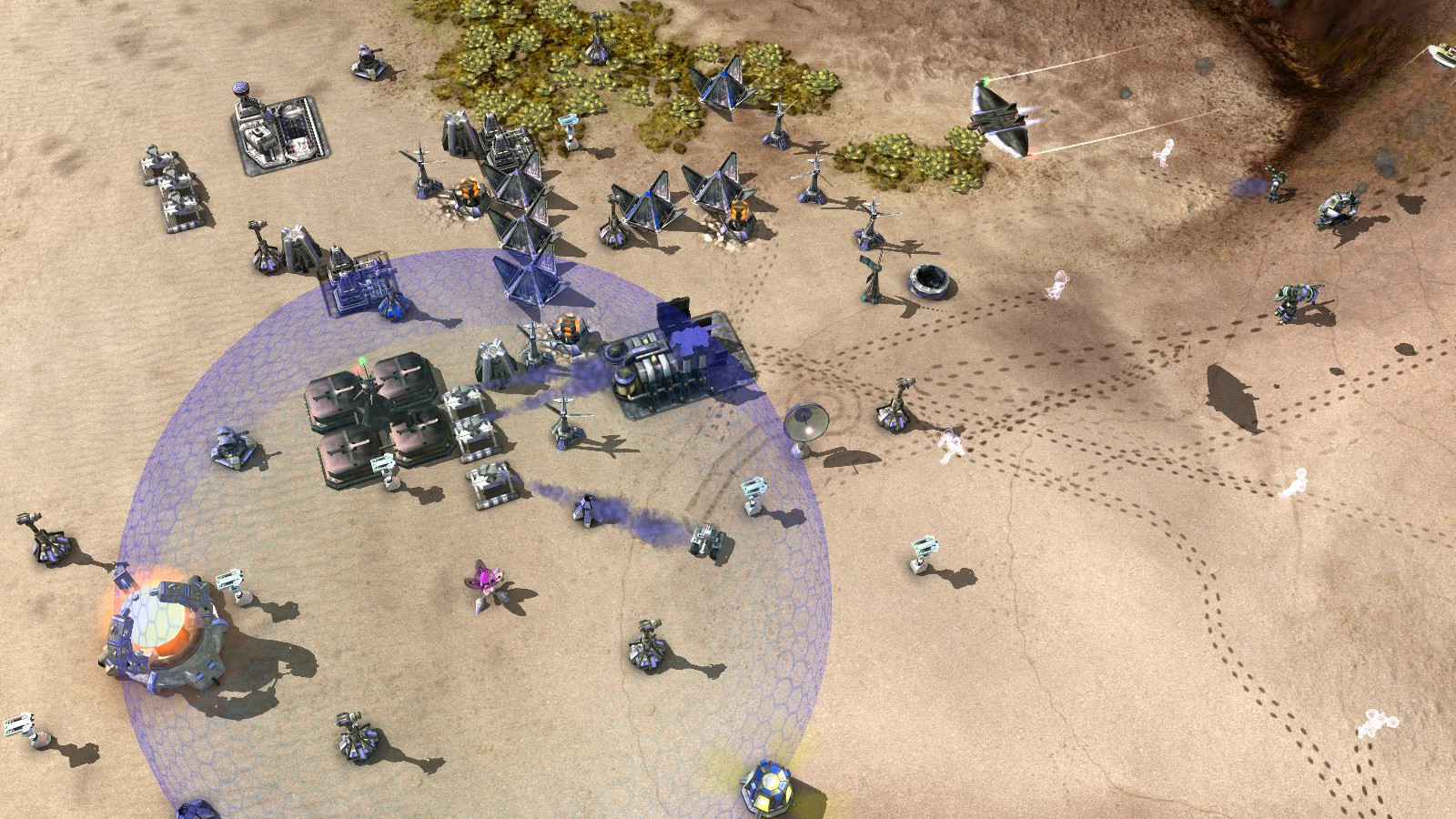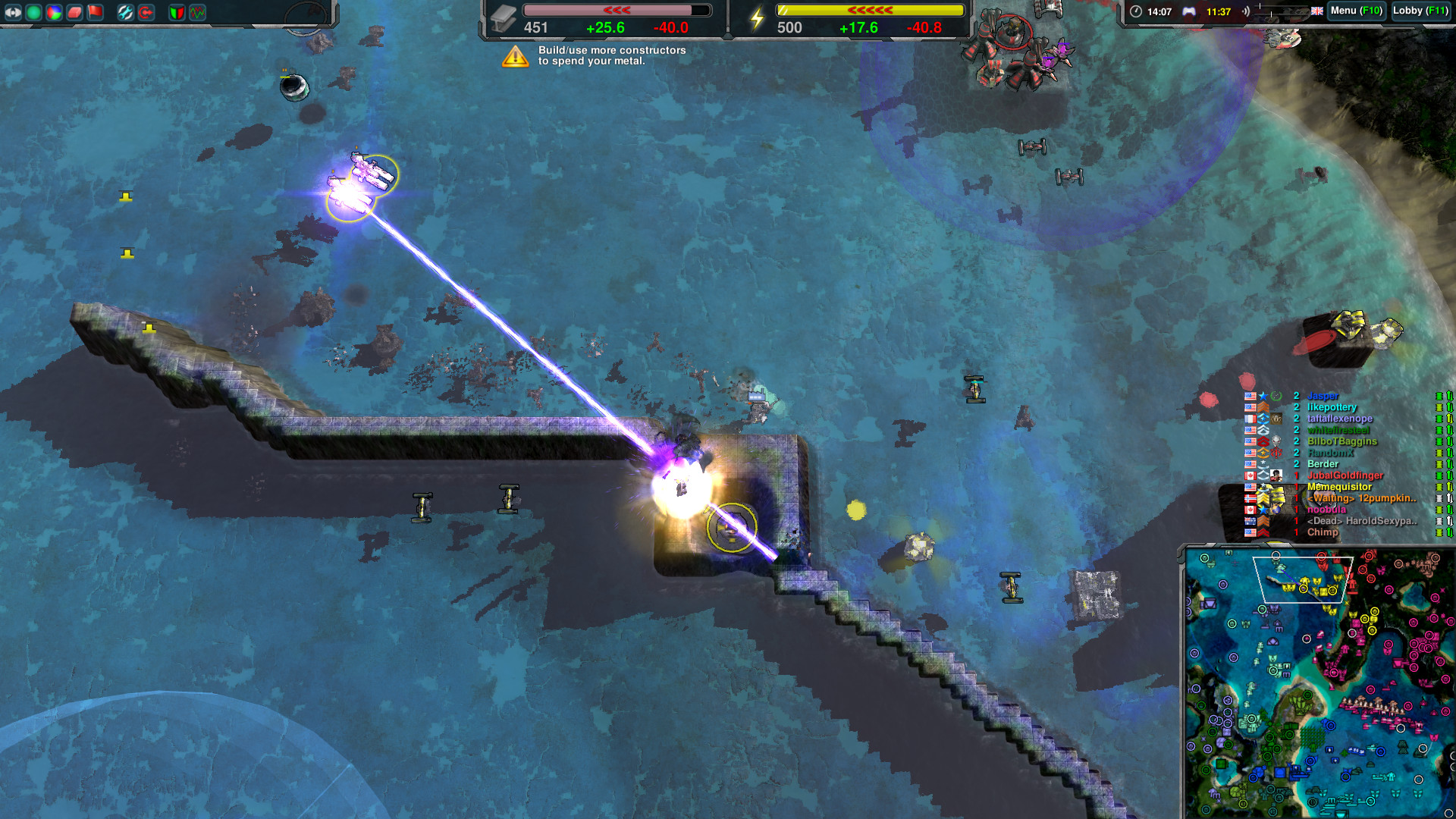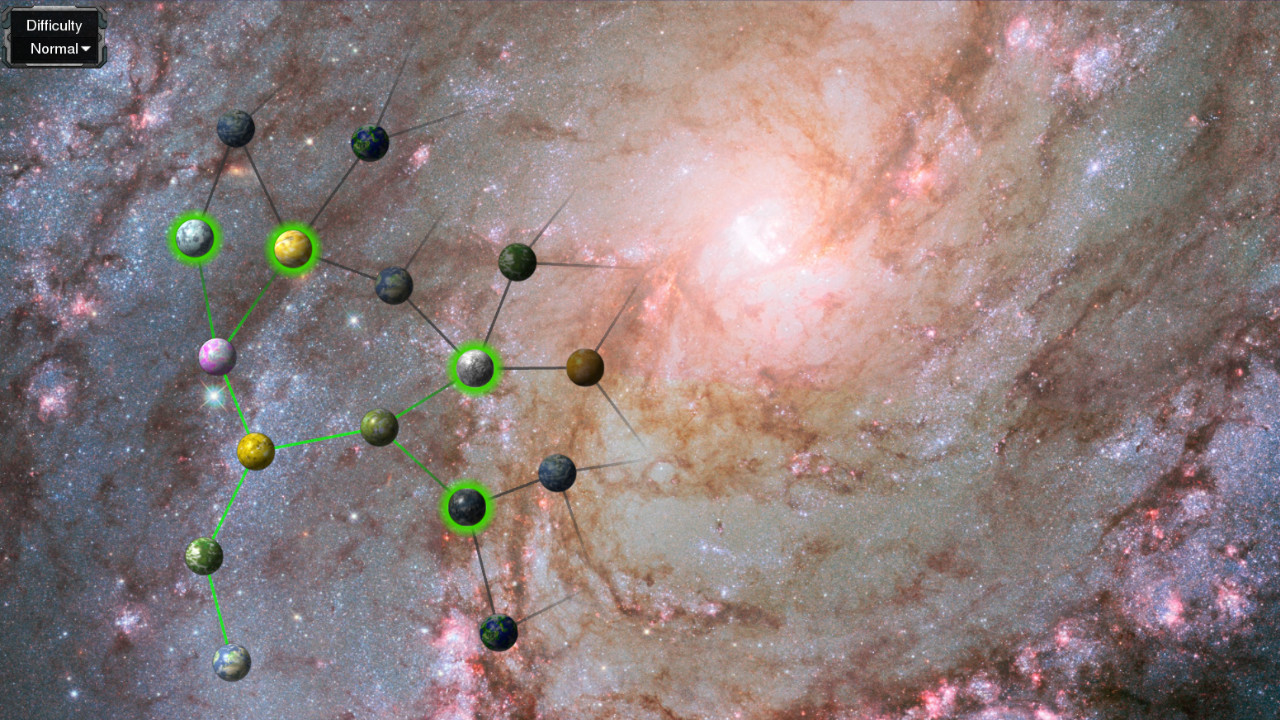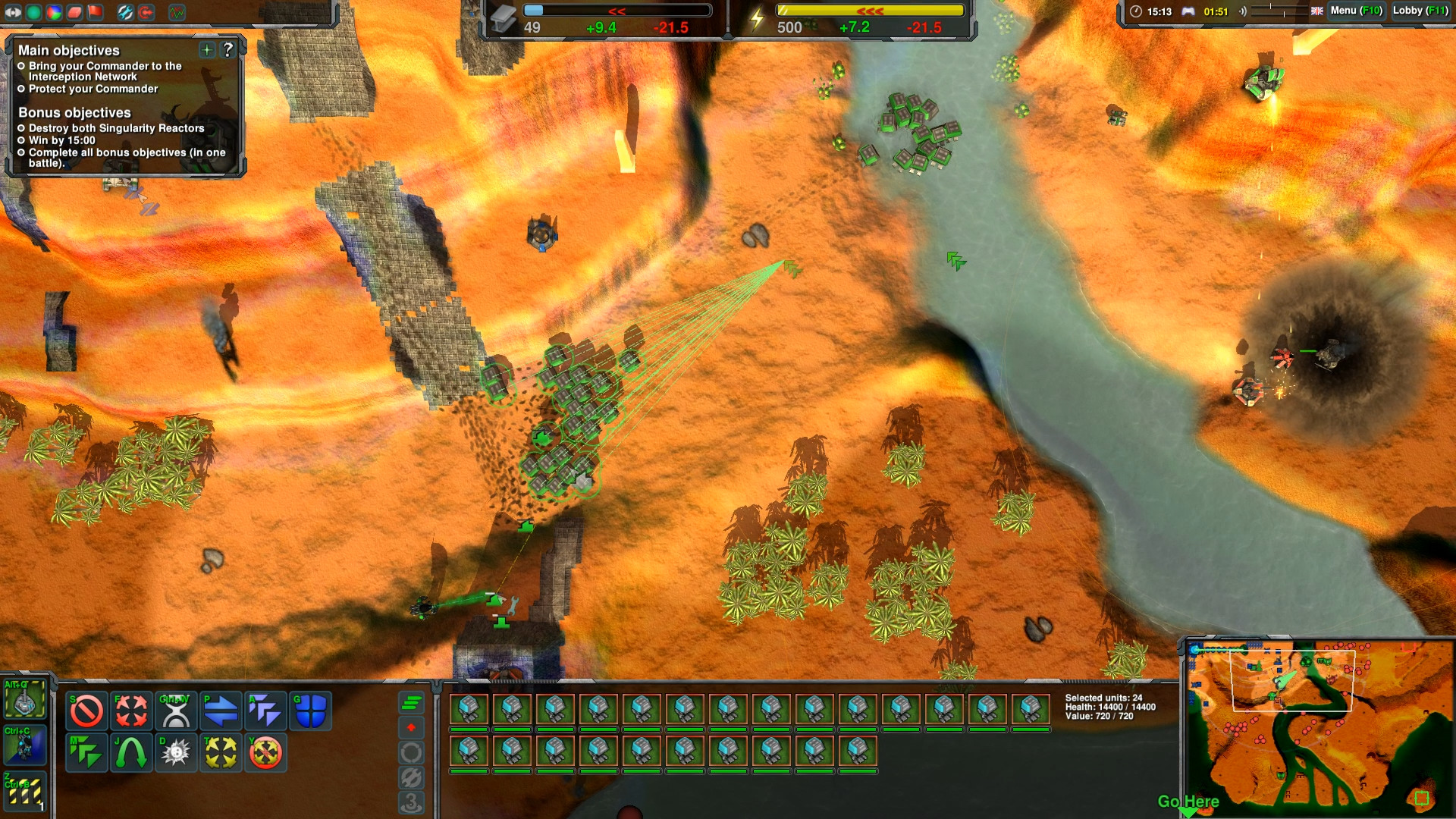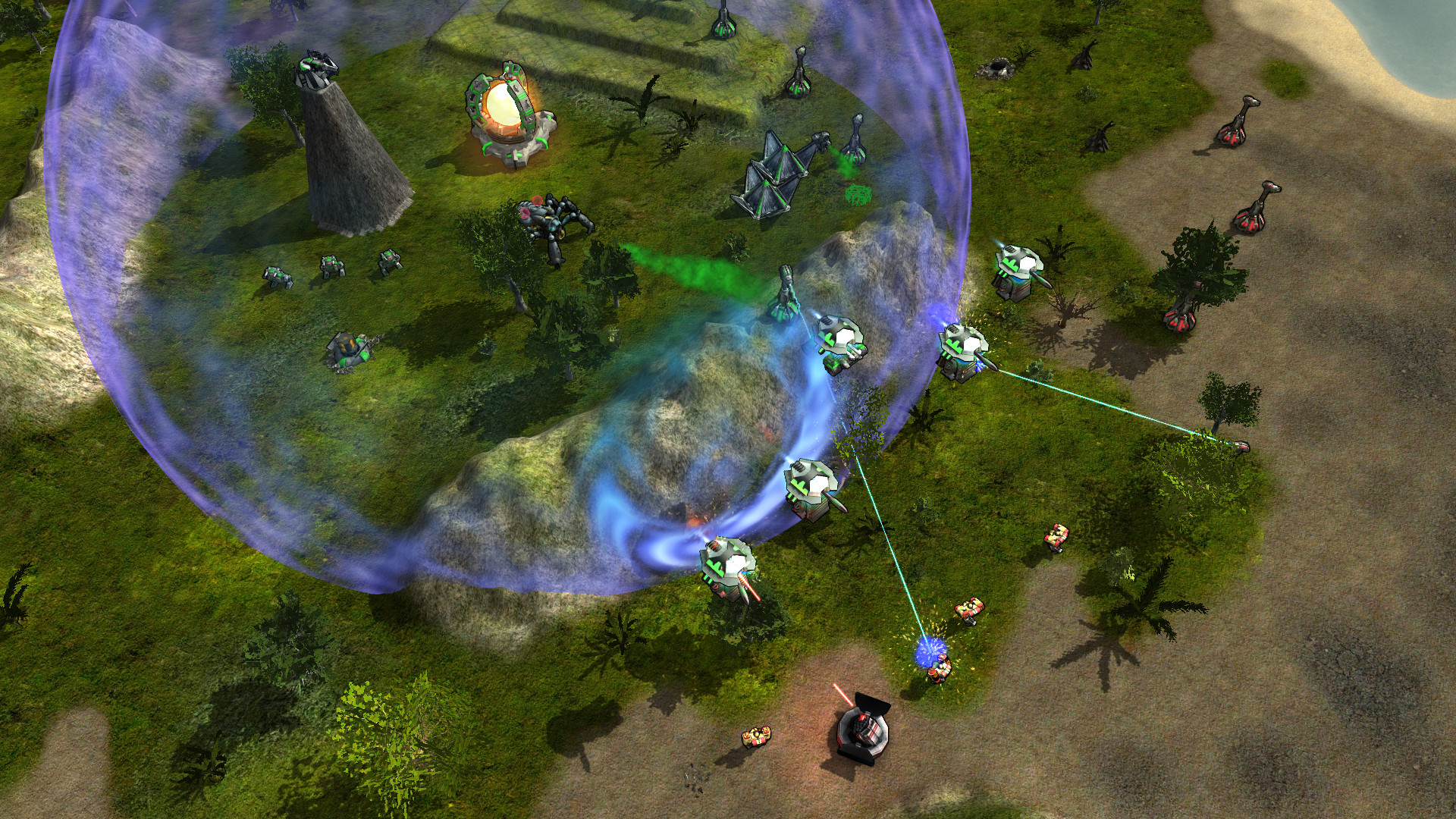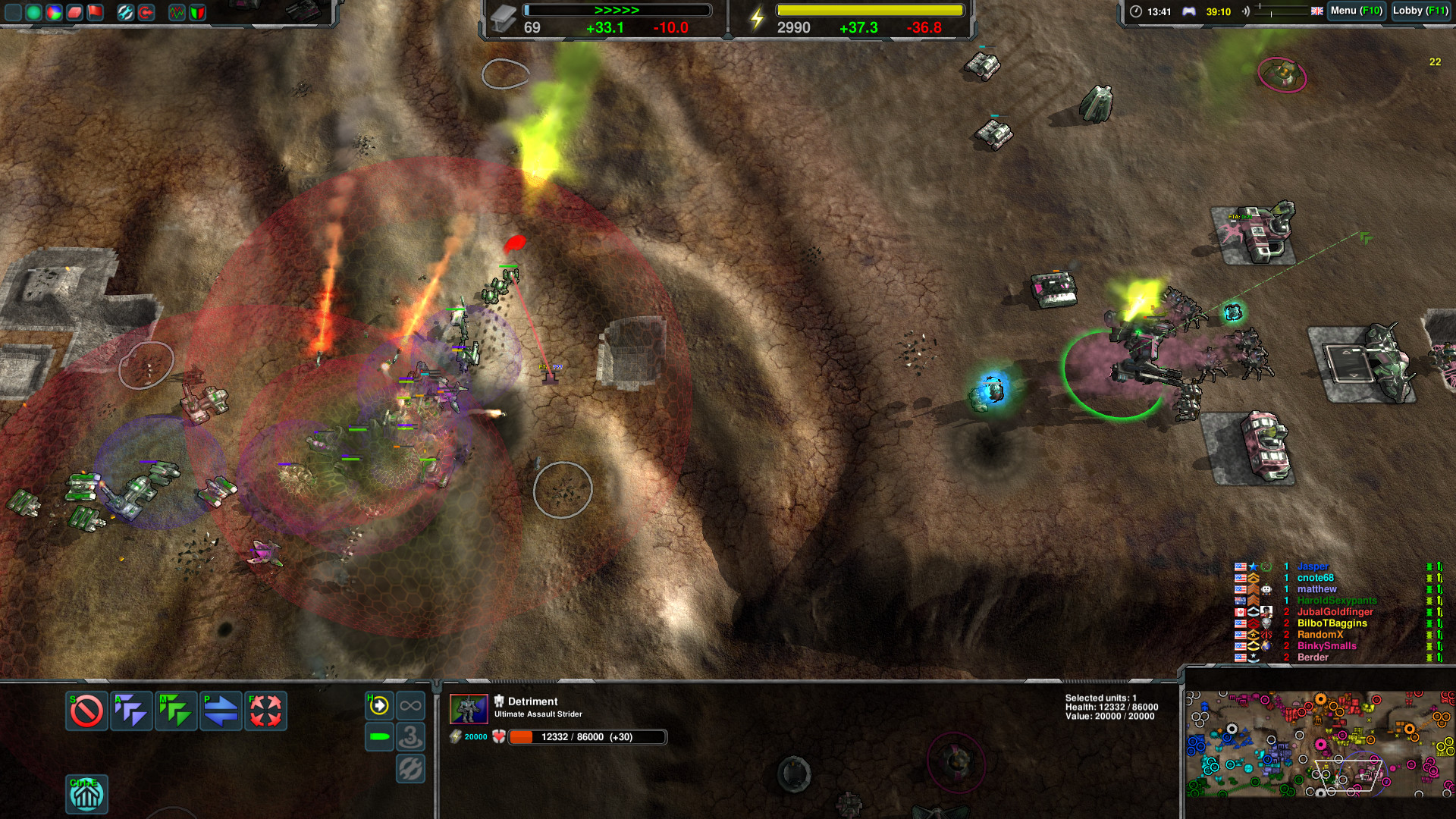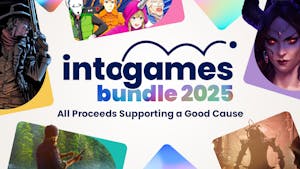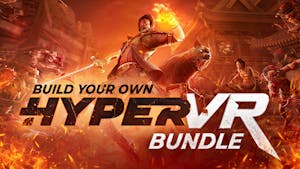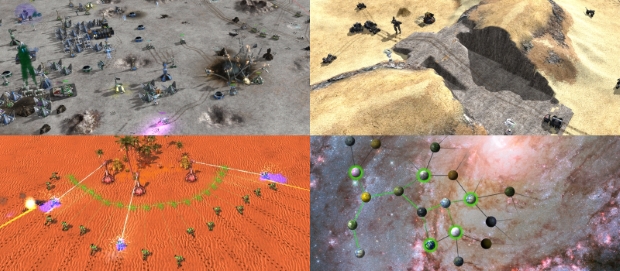
Commander wanted! Construct giant robots, build an army of a thousand Fleas. Move mountains if needed. Bury the enemy at all cost!
- Traditional real time strategy with physically simulated units and projectiles.
- 100+ varied units with abilities including terrain manipulation, cloaking and jumpjets.
- 70+ mission galaxy-spanning campaign to be enjoyed solo or co-op with friends.
- Challenging, (non-cheating) skirmish AI and survival mode.
- Multiplayer 1v1 - 16v16, FFA, coop. ladders, replays, spectators and tournaments.
- PlanetWars - A multiplayer online campaign planned to start in May.
- Really free, no paid advantages, no unfair multiplayer.
Fully Utilized Physics
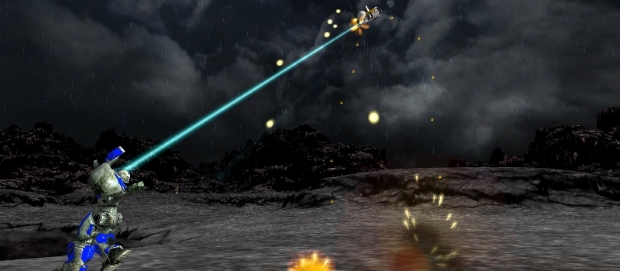
Simulated unit and projectile physics is used to a level rarely found in a strategy game.
- Use small nimble units to dodge slow moving projectiles.
- Hide behind hills that block weapon fire, line of sight and radar.
- Toss units across the map with gravity guns.
- Transport a battleship to a hilltop - for greater views and gun range.
Manipulate the Terrain
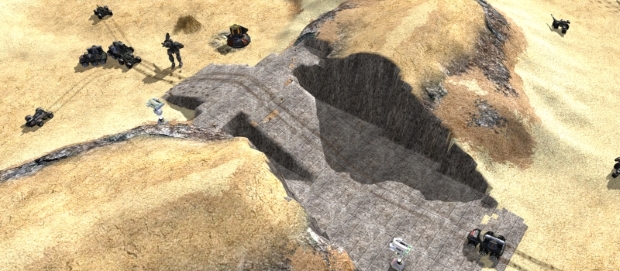
The terrain itself is an ever-changing part of the battlefield.
- Wreck the battlefield with craters that bog down enemy tanks.
- Dig canals to bring your navy inland for a submarine-in-a-desert strike.
- Build ramps, bridges, entire fortress if you wish.
- Burn your portrait into continental crust using the planetary energy chisel.
Singleplayer Campaign and Challenging AI
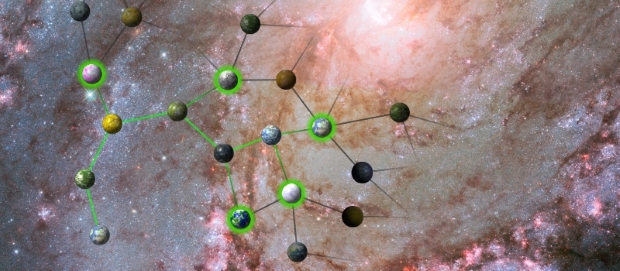
Enjoy many hours of single player and coop fun with our campaign, wide selection of non-cheating AIs and a survival mode against an alien horde.
- Explore the galaxy and discover technologies in our singleplayer campaign.
- Face a challenging AI that is neither brain-dead nor a clairvoyant cheater.
- Have some coop fun with friends, surviving waves of chicken-monsters.
- Cloaking? Resurrection? Tough choices customizing your commander.
Casual and Competitive Multiplayer
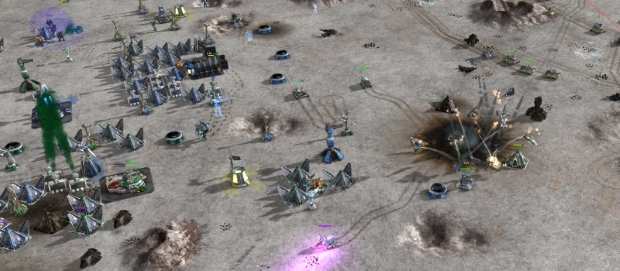
Zero-K was built for multiplayer from the start, this is where you can end up being hooked for a decade.
- Enjoying epic scale combat? Join our 16v16 team battles!
- Looking for a common goal? Fight AIs or waves of chicken-monsters.
- Prefer dancing on a razor's edge? Play 1v1 in ladder and tournaments.
- Comebacks, betrayals, emotions always running high in FFA.
- Want to fight for a bigger cause? Join PlanetWars, a competitive online campaign with web-game strategic elements, diplomacy and backstabbing (currently on hiatus pending an overhaul).
Power to the People
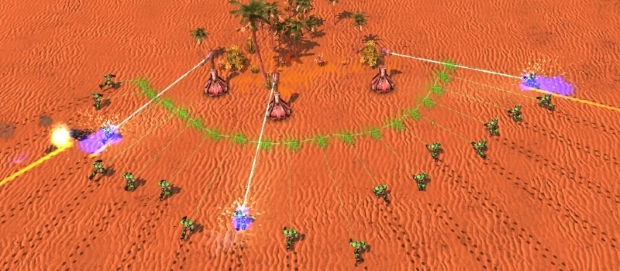
We are RTS players at heart, we work for nobody. We gave ourselves the tools we always wanted to have in a game.
- Do what you want. No limits to camera, queue or level of control.
- Paint a shape, any shape, and units will move to assume your formation.
- Construction priorities let your builders work more efficiently.
- Don't want to be tied down managing every unit movement? Order units to smartly kite, strafe or zig zag bullets.
Plenty of Stuff to Explore (and Explode)
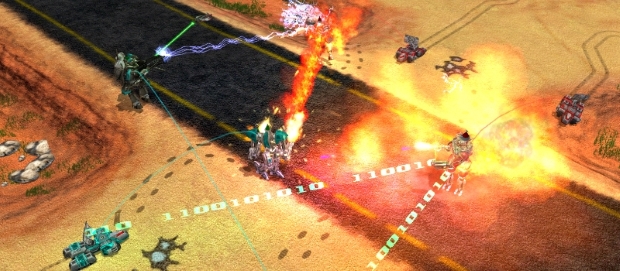
Zero-K is a long term project and it shows, millions hours of proper multiplayer testing and dozens of people contributing ever expanding content.
- Learn to use all of our 100+ units and play on hundreds of maps.
- Invent the next mad team-tactics to shock enemies and make allies laugh.
- Combine cloaking, teleports, shields, jumpjets, EMP, napalm, gravity guns, black hole launchers, mind control and self-replication.
- Tiny flea swarm that clings to walls?
- Jumping "cans" with steam-spike?
- Buoys that hide under water to ambush ships?
- Mechs that spew fire and enjoy being tossed from air transports?
- Carrier with cute helicopters?
- Jumping Jugglenaut with dual wielding gravity guns?
- Meet them in Zero-K!
Zero-K is freer than the average free game. Even the fact that none of it is locked behind payment or grind surprises people, but it goes deeper than that. Zero-K is free software that anyone is able to modify to suit their use, provided they also share it freely. This might be even more surprising. Surely it cost quite a bit to make a fully-featured RTS, so why is it all free - and who paid for it? In short, nobody was paid for anything, because Zero-K was entirely built by volunteers in their free time. It all works because it is free.
First, some caveats, since the above is technically incorrect in a few ways. Donations cover the cost of running the server, and these donations are rewarded with commander skins and a badge on the forums. Which means there is something to buy, although it is nowhere near the scale of full cosmetics stores. I also have a Patreon of a few hundred dollars per year, and if you want to get really nitpicky, then sequential missions in a campaign are technically a form of locked content.
Zero-K inherited its license from the early community around the underlying engine, the Spring Engine. Spring was created by a Total Annihilation clan called the Swedish Yankspankers, and was initially designed to run TA content. They released the engine in 2005 under the GNU General Public License (GPL), which essentially allows anyone to modify their code provided that they release the changes under the same license. I do not know why they picked the GPL, perhaps they were involved in free software more broadly, but it seems like it was a deliberate choice.

The GPL is a restrictive license in the sense that it limits your ability to retract the freedoms it provides, but this is great for contributors who want their work to remain free. So Spring attracted developers and grew, as did the games it ran. The GPL also applied to code included in the games themselves, which formalised the kind of sharing common to well-functioning modding communities. This expanded the effective feature list of the engine faster than any team could do alone, for example, morph and jumpjets are game-side gadgets that showed up in a few games. Projects could even split completely to take different directions, which is how Complete Annihilation , the predecessor of Zero-K, forked from Balanced Annihilation. The engine itself was even forked recently (and renamed to Recoil), demonstrating how the GPL allows projects to outlive their maintainers.
It might sound like Spring revokes all notions of ownership, but remember, games are not just code. The license treats games as packages of content with independent licenses, and explicitly omits art from the GPL. There was even a commercially released game called P.U.R.E. that put proprietary licenses on its art. Some of the rationale for the carve-out was that art is static and game-specific in ways that code is not, so most reasons to share code are absent from shared art. In any case, it means that Zero-K is freer than the engine licenses require, so we need to cover a bit more of the history of early Spring.
Spring was in an awkward spot in the late 2000s. A handful of Total Annihilation mods had been ported to Spring and were still using TA models from 1997. This was, at best, legally dubious, and did not look good, especially to the developer of non-TA games who put in the work to make original art. The art carve-out was even clarified to avoid the nice new art lazily appearing alongside stolen TA content, without permission. So the idea of replacing the TA models was ever-present in the community, with modellers releasing packs of models from time to time, all released in the spirit of free software. Complete Annihilation was the first game to embrace this goal, and we even set up a model repository to track remodelling efforts.

Zero-K was born of the final push to rid Complete Annihilation of the old TA content. At some point we realised that most of the remaining old models were units or structures that were essentially duplicated between Arm and Core, so we focused our efforts on remodelling the remaining interesting units, and dropped the rest. This was the impetus behind factories as factions , although it is also backed by solid design principles. Some remodelling of remodels continued after Zero-K emerged, as well as the addition of new units in cases where an old unit was remodelled multiple times. This is why both Jack and Buoy are based on the old Can.
Zero-K continues to be free to honour the dozens of people who contributed with the understanding that it would remain free. That, and the non-commercial licenses used for some of the models, and most of the sounds. The disadvantage is that volunteers are often low on free time, and boring tasks languish, but the advantage is that anyone can contribute. There are no licenses to navigate, just clone the repository and start developing. The occasional player gets involved, builds their expertise, and becomes part of the development team. It is how I started, although it is admittedly harder with less low hanging fruit to be plucked. Luckily, the licensing of Zero-K also makes modding a great place to start.

The volunteer development model continues to pay off, with many of the coolest features of the last few years being one-off projects by keen community members. ThornEel's plasma cannon trails are just the most recent example. These improvements compound over time and have the advantage of addressing what at least one player would like to see, rather than being handed down by a developer who might not play the game. Everyone being a volunteer means that these ideas can take longer to bring to fruition, but some tasks even benefit from being worked on slowly. For example, changes to terraforming and aircraft had to percolate through the playerbase for years, with the long timeframe giving us the time to iterate and get things right.
Most ideas can be tackled relatively quickly and a lot can be learnt on the job. We especially need volunteers in our weaker areas, such as marketing. If you would like to see something polished up or added to Zero-K, come talk to the current volunteers and consider contributing.
Index of Cold Takes
P.S. I've been using the term Free Software over Open Source on the advice of Richard Stallman to push back against the corporate open source bandwagon. The strengths of Zero-K and Spring/Recoil come from being free, not merely being open source.
Minimum Setup
- OS: Ubuntu 13.04 or equivalent
- Processor: 2.0 GHz dual core CPU with SSE (Intel Core 2 Duo or equivalent)Memory: 4 GB RAM
- Memory: 4 GB RAM
- Graphics: 512 MB graphics card with OpenGL 3 support (GeForce 8800 or equivalent)
- Storage: 6 GB available spaceAdditional Notes: 64bit only. Big Picture mode is not supported
Recommended Setup
- OS: Ubuntu 17.10 or equivalent
- Processor: 3.0 GHz quad core CPU (Intel Core i5 or equivalent)Memory: 8 GB RAM
- Graphics: 2048 MB graphics card with OpenGL 3 support (high GT 500 series or equivalent)Network: Broadband Internet connection
- Storage: 8 GB available spaceAdditional Notes: 64bit only. Big Picture mode is not supported
[ 6444 ]
[ 2268 ]
[ 1913 ]

